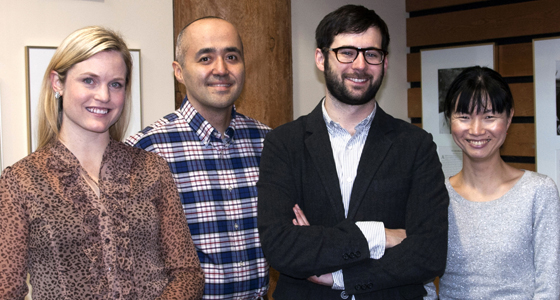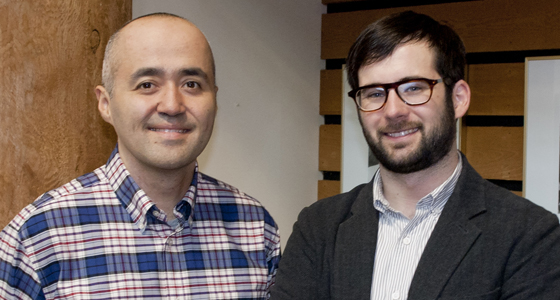Hanae Tsukada, Professional Development Coordinator at the Centre for Teaching, Learning and Technology (CTLT), works on issues of diversity and inclusivity in teaching and learning at UBC. She writes about her learning experience and illustrates the complexity behind Aboriginal student data.
“How many Aboriginal students are there at UBC?”

Amy Perreault, Graeme Joseph, Thane Bonar, and Hanae Tsukada
According to Graeme and Thane, undergraduate admissions first began asking students to self identify in 1997, when the Aboriginal Admissions Policy was passed. According to Jenny Phelps, Assistant Dean at the Faculty of Graduate Studies, Aboriginal student numbers can also go back as far as 1997-98 in the Faculty of Graduate Studies. However, Jenny infers that the numbers available between 1997 and 2004 most likely represent only graduate student applicants who had already self-identified as undergraduate students at UBC. This might not encompass the actual number of all applicants who would self-identify as Aboriginal.

Graeme Joseph and Thane Bonar
I was surprised to learn from Graeme and Thane that it was only as recently as 2004 that UBC started to systematically collect data on Aboriginal student applicants. Moreover, although all self-identification data is now entered into the UBC Student Information System (SIS) in a systematic manner, Aboriginal student data continues to have serious limitations due to the fact that many Aboriginal students may choose not to self-identify. According to Thane, for some students, this decision likely stems from “experiences of racism and a distrust of government and education institutions.” Graeme echoes, “simply put, self-identifying as Aboriginal made you a target for racism, so many people took the strategy of not self-identifying (this, of course, is still a part of the everyday life of Aboriginal peoples).” Even though it is not known how many Aboriginal students actually choose not to self-identify, based on cross-checking with other sources, the First Nations House of Learning estimates that at least 30% make this choice.
Aboriginal students’ reluctance to self-identify goes beyond a personal, self-protective strategy. Government or institutional efforts to collect information on Aboriginal people has often been a disservice to them. Thane elaborates:
Whenever one sets out to count Aboriginal students, or anything for that matter, it is usually towards some end besides just having a number. It is to inform policy, make an argument, determine budgets, etc., and the Aboriginal experience in Canada has shown that these ends are not always in the best interest of Aboriginal people. It is often used, for example, to cut funding or discredit/disempower Aboriginal organizations. Moreover, these counts inherently require definitions of “Aboriginal,” “First Nations,” or “Indigenous” that are often imposed and inaccurate.
Currently, UBC has a count of Aboriginal students, broadly defined as First Nations (status or non-status), Métis, or Inuit, that it uses for statistical and policy development purposes. Thane notes that there is an understanding that the number is not perfect, but data collection is consistent year to year, so it is still meaningful. The data shows that the Aboriginal community is growing each year across both UBC campuses. However, Thane cautions that it is not known how much of the increase is due to more students self-identifying.
“It is our hope that students will feel increasingly comfortable identifying as Aboriginal to UBC,” states Thane. To that end, it is essential to ensure that the data is being collected and used in order to help students, and that the University is transparent and open about what it is collecting and why. Graeme explains further:
A lot of the work that we have done around this issue [of self-identification] is to inform students why this information is important, why it benefits them to self-identify, how we plan to use it and protect it. The benefit for self-identifying is helping us help students.
Despite the challenges of self-identification, Graeme and Thane see the value of striving to collect more accurate data on Aboriginal students for the benefit of both students and the University. The data can, for example, help the University identify the distribution of Aboriginal students across the campus and develop effective policies and programs by allocating resources appropriately.
Consultation with Thane and Graeme has led me to numerous moments of reflection and learning, but what struck me most was the challenge of “just counting” Aboriginal students, and the historical and political complexity behind it. Even though I already knew that self-identification was a sensitive issue for many Aboriginal people, I did not realize that their concerns manifest in such a concrete and significant way on this campus, in the present day. Learning about the historical and political complexities behind the number of Aboriginal students has led me to think that, for those of us who strive to understand and better support Aboriginal students, understanding the complexities should be the first step, rather than looking for any quick facts. To gain such understanding, it is invaluable to consult experts who are knowledgeable about the issues in our own institutional setting.
Acknowledgement
In addition to those who are identified in this article, I would also like to thank Kim Lawson, Reference Librarian at the Xwi7xwa Library, for her help with my literature search, and the First Nations Studies Program at UBC for their web-based resource, which contributed to enhancing my learning about Aboriginal histories in Canada.
UBC is committed to developing a better awareness and understanding of the Indian Residential School system that operated in Canada from 1875-1996, and had a profound impact on First Nations communities and the relations between Aboriginal people and a wider Canadian society. From September 18 – 21, 2013, the Truth and Reconciliation Commission of Canada will be conducting the last of its National Events to be held on the west coast in Vancouver. UBC has taken the extraordinary step of suspending classes on September 18 so that students, faculty, and other members of the UBC community might more fully participate in this historic event, and many initiatives are underway on campus to plan and prepare for this event. More information can be found at: http://irsi.aboriginal.ubc.ca/purpose.
To learn more about these initiatives and how to get involved, please contact Amy Perreault, CTLT Aboriginal Initiatives Coordinator, at amy.perreault@ubc.ca.
This article was published in the March 2013 CTLT Newsletter, Dialogues. Below is a list of the articles included in the issue:
- Faculty Spotlight – 3M National Teaching Fellow Dr. Darren Dahl
- Online Peer Assessment in MOOCs: Students Learning from Students
- Connect: Looking Back and Looking Forward
- Learning About the Social Complexity Behind Aboriginal Student Data (currently viewing)
- 2013 CTLT Institute
- New Teaching and Learning Resources
- Other Professional Development Opportunities
Find out more information about the CTLT Newsletter, Dialogues.
Comments are closed, but trackbacks and pingbacks are open.